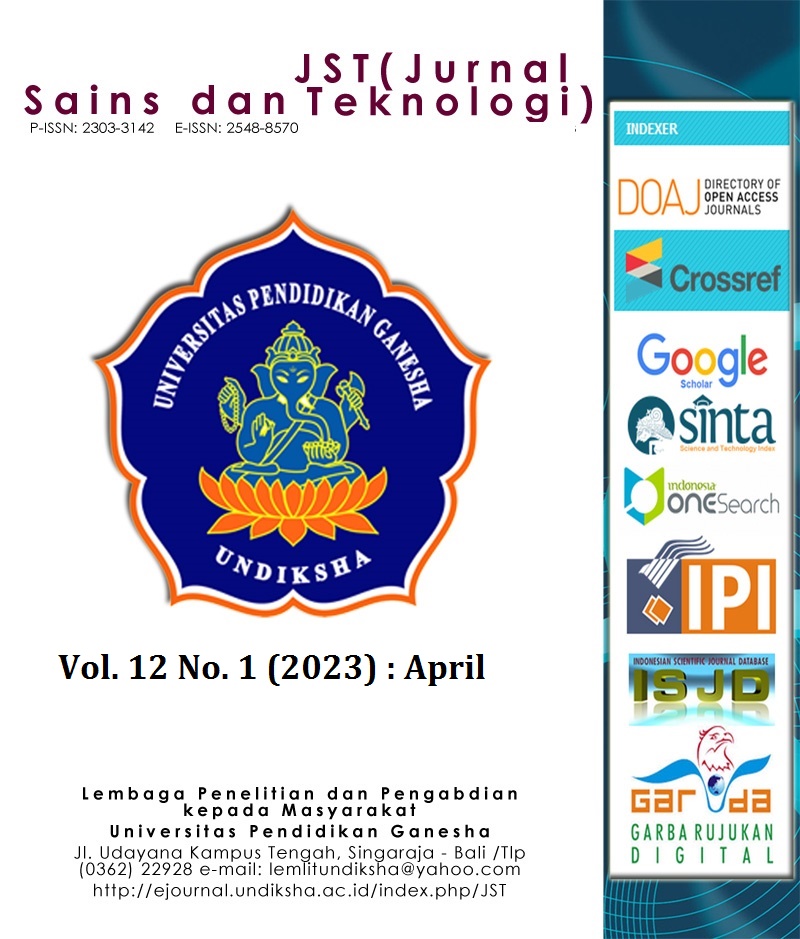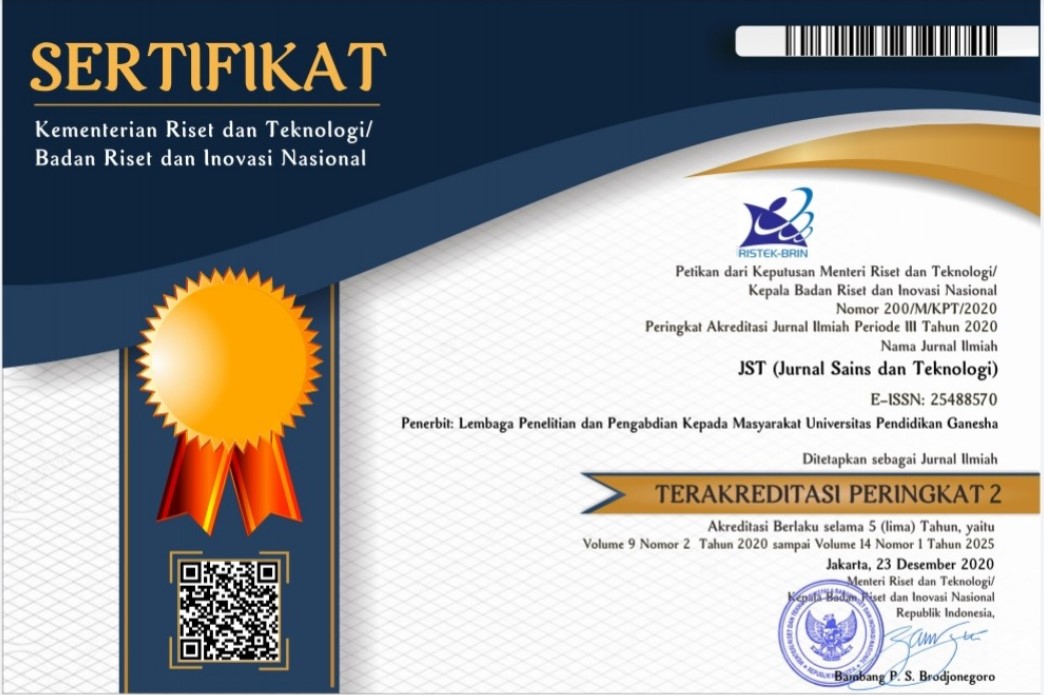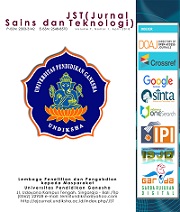GPS-Based Rocket Payload Position Tracking System
DOI:
https://doi.org/10.23887/jstundiksha.v12i1.55069Kata Kunci:
Tracking System, Rocket Payload Payload, Global Positioning System (GPS), ArduinoAbstrak
Kementerian Riset, Teknologi, dan Pendidikan Tinggi (Kemenristek Dikti) Indonesia secara rutin menyelenggarakan kompetisi payload tracking system yang ditempatkan di roket dengan Ground Control Station (GCS), kompetisi yang dikenal dengan Kompetisi Muatan Roket dan Roket Indonesia (KOMURINDO). Antena GCS yang diperbaiki menyebabkan beberapa masalah, termasuk komunikasi yang buruk antara payload dan GCS dan deteksi posisi payload. Penelitian ini dilakukan untuk membuat sistem tracking yang mampu menggerakkan antena pada GCS ke arah posisi payload. Pada penelitian ini digunakan dua buah servo untuk menggerakkan antena.Sistem pelacakan posisi payload untuk roket berbasis GPS bekerja dengan cara menghitung sudut azimuth koordinat GCS dan sudut payload, kemudian mengubah nilai azimuth menjadi nilai sudut servo. Perhitungan dilakukan oleh Arduino Mega 2560 yang kemudian memerintahkan servo horizontal dan vertikal untuk mengarahkan antena menuju posisi payload.
Eksperimen dilakukan dengan tiga pengujian utama yaitu pelacakan posisi payload berdasarkan data GPS, pergerakan arah antena dengan arah gerak servo horizontal, dan pergerakan arah antena dengan arah gerak vertikal servo. Pengujian dilakukan dengan meletakkan muatan pada drone dan mengatur posisi dan ketinggian drone secara manual. Hasil penelitian menunjukkan bahwa sistem tracking bekerja dengan baik dalam menentukan arah azimuth berdasarkan data posisi koordinat yang dikirimkan oleh payload.
Referensi
A., A., A., D., H.A., F., & A.M., H. (2019). Flight Trajectory Control System on Fixed Wing UAV using Linear Quadratic Regulator. International Journal of Engineering Research & Technology (IJERT), 8(6). https://doi.org/10.17577/IJERTV8IS080135.
A., N., R., J., & N.F, R. (2020). Penerapan Metode Haversine Formula Untuk Penentuan Titik Kumpul pada Aplikasi Tanggap Bencana,. Metik, 4(2). https://doi.org/10.47002/metik.v4i2.190.
A.El., B., K., E. K., A., T., & H., Q. (2021). A Design of Telemetry System for Small Animals. Journal of Communications Software and Systems, 17(3), 244–253. https://doi.org/10.24138/jcomss-2021-0065.
A.M., K., & H., S. B. (2020). Transient excitation, in Structural Dynamics Fundamentals and Advanced Applications,. Science Direct.
Arduino. (2022). Arduino Mega 2560,.
Azdy, R. A., & F., D. (2020). Use of Haversine Formula in Finding Distance Between Temporary Shelter and Waste End Processing Sites. J. Phys.: Conf. Ser., 1500(012104.). https://doi.org/10.1088/1742-6596/1500/1/012104.
Buchori, I., Sugiri, A., Mussadun, M., Wadley, D., Liu, Y., Pramitasari, A., & Pamungkas, I. T. D. (2018). A predictive model to assess spatial planning in addressing hydro-meteorological hazards: A case study of Semarang City, Indonesia. International Journal of Disaster Risk Reduction, 27, 415–426. https://doi.org/10.1016/j.ijdrr.2017.11.003.
Cantanhede, N. R., Carvalho, E. E., Jesus, P. F. D. S., & Barros, J. J. De. (2022). Tracking and impact point of survey rocket by Telemetry and Slant-Range device. ENGINEERING SCIENCES, 94(3). https://doi.org/10.1590/0001-3765202220200471.
Griffiths, H. (2022). The Yagi Antenna. IEEE Aerospace and Electronic Systems Magazine, 37(1), 4–5. https://doi.org/10.1109/MAES.2021.3127141.
Hidayah, Q., Salamah, U., & Sasono, M. (2022). Analisis Uji Peluncuran Roket Air Berbasis Carbon Fiber menggunakan Sistem Telemetri. Jurnal Teori Dan Aplikasi Fisika, 10(1), 81–88. https://doi.org/10.23960%2Fjtaf.v10i1.2912.
Kelechi, A. H., Alsharif, M. H., Oluwole, D. A., Achimugu, P., Ubadike, O., Nebhen, J., … Uthansakul, P. (2021). The Recent Advancement in Unmanned Aerial Vehicle Tracking Antenna: A Review. Sensors, 21(6), 5662. https://doi.org/10.3390/s21165662.
LAPAN. (2020). LAPAN Annual Report - 2020. Lembaga Penerbangan dan Antariksa Nasional. Retrieved from https://kong.lapan.go.id/service-files/service-archives/1629424534.pdf.
Mudarris, Basirung, M. R., & Sumariyanto, I. (2022). Rocket Load Test Based On Inertial Measurement Unit Sensor In Supporting National Air Defense. Jurnal Pertahanan, 8(1), 1–10. https://doi.org/10.33172/jp.v8i1.1496.
Nugraha, I. M. A., Desnanjaya, I. G. M. N., Pranata, I. W. D., & Harianto, W. (2021). Stability Data Xbee S2b Zigbee Communication on Arduino Based Sumo Robot. Journal of Robotics and Control (JRC). https://doi.org/10.18196/jrc.2370.
Putra, A. A., & Zuhrie, M. S. (2019). Rancang Bangun Payload dan Interface Monitoring Roket dalam Visualisasi 3D dan Pengambilan Foto. 8(3),. Jurnal Teknik Elektro, 8(3), 673–678. Retrieved from https://ejournal.unesa.ac.id/index.php/JTE/article/view/29458.
R., K., P., S., K., H., J., S., Socha., L., S., & Kutílek P. (2017). Wearable Modular Telemetry System for the Integrated Rescue System Operational Use. Journal of Sensors. https://doi.org/10.1155/2017/9034253.
R.E., M., H.A., R., M., A., M., J., & M.E.M., S. (2019). An Enhanced Gain of Yagi-Uda Antenna with Folded Dipole for Amateur Radio VHF Band Application. Journal of Physics: Conference Series, 1175 01206. https://doi.org/10.1088/1742-6596/1175/1/012064.
Restrepo, C. I., Carson, J. M., Amzajerdian, F., Seubert, C., Lovelace, R., McCarthy, M., … Collins, and S. (2018). Open-Loop Performance of COBALT Precision Landing Payload on a Commercial Sub-Orbital Rocket. Session: EDL_GN&C: Entry, Descent, and Landing GN&C Technology I. https://doi.org/10.2514/6.2018-0613.
Riyandi, A., Sumardi, & Prakoso, T. (2018). PID Parameters Auto-Tuning on GPS-based Antenna Tracker Control using Fuzzy Logic. Jurnal Teknologi Dan Sistem Komputer., 6(3). https://doi.org/10.14710/jtsiskom.6.3.2018.122-128.
Salim, C. (2021). Regional Maritime Security Challenges Amongst the Indo-Pacific’s Emerging Geopolitics. In Nusantara Maritime. Indonesian Naval Command and Staff College., 1(3).
T., S., & Schlicker S. (2022). Trigonometry. Grand Valley State University.
Z.B., H., Wardi, & G., T. (2019). Low Cost Antenna Design for the Application of Over the Horizon Surface Wave Radar. International Journal of Innovative Technology and Exploring Engineering (IJITEE), 9(2), 2215–2218. https://doi.org/10.35940/ijitee.B6615.129219.
Unduhan
Diterbitkan
Cara Mengutip
Terbitan
Bagian
Lisensi
Hak Cipta (c) 2023 Dewa Made Wiharta

Artikel ini berlisensiCreative Commons Attribution-ShareAlike 4.0 International License.
Authors who publish with the Jurnal Sains dan Teknologi (JST) agree to the following terms:
- Authors retain copyright and grant the journal the right of first publication with the work simultaneously licensed under a Creative Commons Attribution License (CC BY-SA 4.0) that allows others to share the work with an acknowledgment of the work's authorship and initial publication in this journal.
- Authors are able to enter into separate, additional contractual arrangements for the non-exclusive distribution of the journal's published version of the work (e.g., post it to an institutional repository or publish it in a book), with an acknowledgment of its initial publication in this journal.
- Authors are permitted and encouraged to post their work online (e.g., in institutional repositories or on their website) prior to and during the submission process, as it can lead to productive exchanges, as well as earlier and greater citation of published work. (See The Effect of Open Access)
















